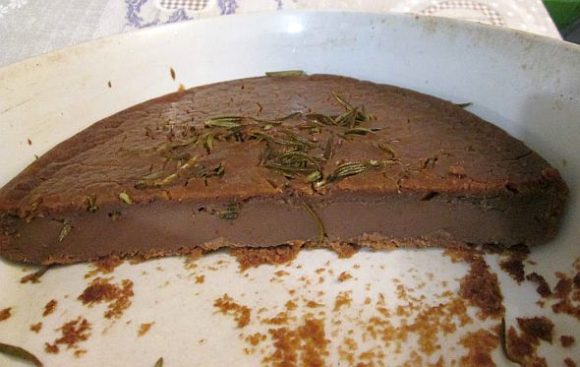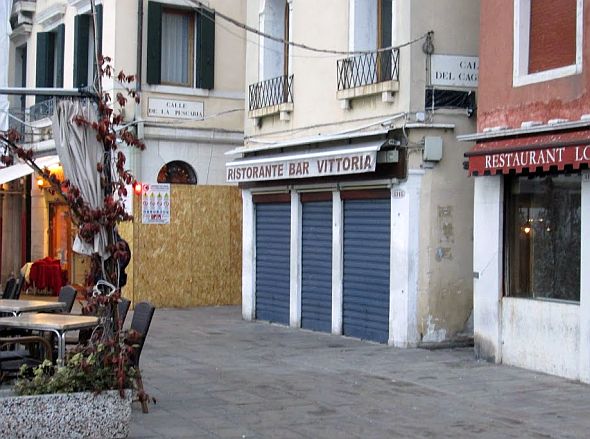
Regional cookery is one of the zillion things that Italy is so proud of and so admired for. (End of preposition storm.) But the funny thing is that a dish will be super-famous as being from one place, and then you discover its stolen-at-birth sibling in a completely different region, and then you discover it again, and again, and sometimes even again. The reason is simple: People all over Italy have the same needs (eating) and many of the same ingredients, and what develops is something like a theme and variations.
Take castagnaccio (kas-ta-NYA-cho). Perhaps its most noted version is from Tuscany, but there are variations from Naples, Corsica, Emilia-Romagna, Liguria, Piemonte, Calabria, and even the Veneto — anywhere there are chestnut trees, in fact. The names may change along the way — baldino, pattona, ghirighio, castigna’, pane di castagna, migliaccio, gnaccia, and in Venice, “gardo” — but the essential ingredients originally couldn’t rise beyond the gravity pull of poverty: chestnut flour and water, and a little olive oil. Then came raisins and pinoli nuts and sugar, even wine and milk and orange peel and chocolate. But I don’t see how you can improve on the basics, which produce something super-dense, not too sweet, and loaded with winter-useful calories (193 per 100 grams).
Chestnuts were the perennial backup when you had no more flour of any sort, and not even polenta. When the countryfolk would burn the effigy on Epiphany (the “befana”), eyes used to be fixed on the direction the sparks flew. People still look, but now it’s more like a game, though it wasn’t always so. The doggerel makes that clear: “Se le falive va a marina / Tol su saco e va a farina / Se le falive va a montagne / Tol su saco e va a castagne” (if the sparks fly toward the sea (east), take your sack and go to make flour (the wheat harvest will be good) / If the sparks fly toward the mountains (west), take your sack and go gather chestnuts.”)
But like so many other “poor” dishes, castagnaccio is apparently being rediscovered by people who have had enough of smoked salmon and foie gras (just an expression — does anybody still eat foie gras?). Anyway, Lino is impervious to fashions and fads. He’s always eaten something, he’s going to continue eating it. Every so often the urge for castagnaccio will strike him and off he goes to acquire some chestnut flour. It is reliably available at the ever-amazing Mascari. (Full disclosure: I have no connection with this shop.) He doesn’t add either pinoli nuts or raisins, but sticks to the bare bones of the recipe, with a sprinkling of rosemary.
Lino remembers that there was a little shop at the corner of the Riva degli Schiavoni and Calle de la Pescaria which sold slices of gardo and also a “cake” made of chickpea flour. That was all, he sold nothing else.

As it happens, however, a bar-cafe in via Garibaldi has recently taken up the baton:

The internet is full of recipes, but here’s the simplest version of castagnaccio, if you want to chance your arm:
Ingredients: 750 ml water, 500 gr chestnut flour, some fresh rosemary “needles,” a pinch of salt, 6 spoonfuls of extra-virgin olive oil, to keep it soft.
Heat the oven to 200 degrees C or 350 F. Put the flour in a bowl and add the water slowly while stirring. Spread a little olive oil on the bottom of the pan. Pour the batter into the pan and bake for one hour. (Note: The pan, or casserole, or whatever you’re using, shouldn’t be so broad that the batter only barely covers it. Use your judgment, but bear in mind that this isn’t going to rise.) The surface of the final product should have slight cracks or fissures.
Modify it as you wish, of course; I’ll never know. In fact, the heathen thought of topping it with whipped cream or ice cream did cross my mind, but I quashed it. We like the basics here.

1 Comment
I remember very well this store. I used to buy slices of castagnaccio (gardo in Venetian) and of the chickpea cake. They also sold chestnut flour.
i have lived in NY city for the last 52 years but this store is unforgettable.
Thank you.